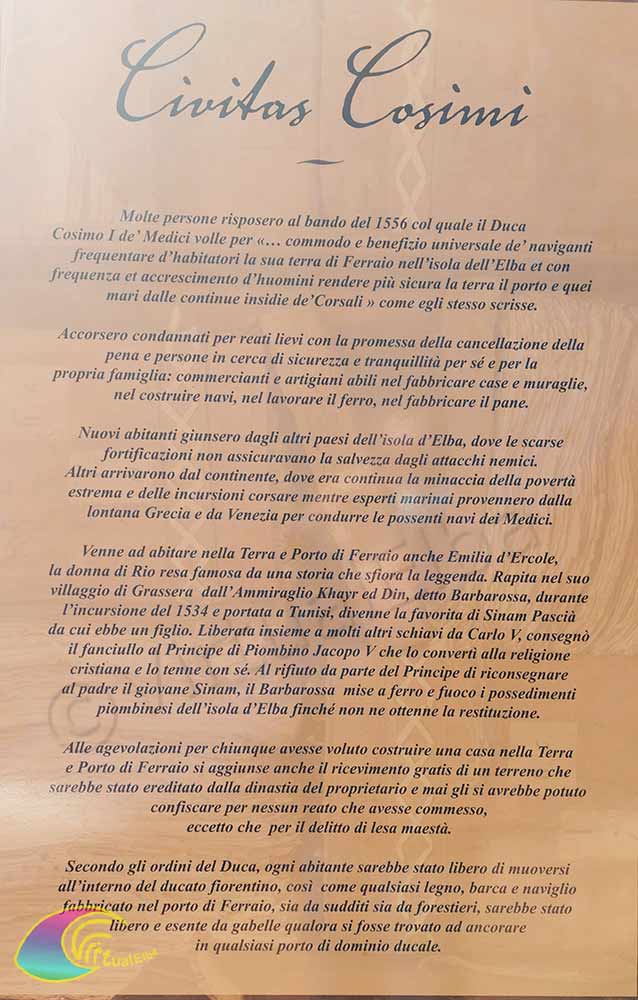The Cultural and Congress Center , named after Cesare De Laugier, a Napoleonic officer of a Portoferraio mother, represents an open gate on the historical memory of the city. It houses the picture gallery with a rich collection of paintings, prints, drawings and furniture from various eras by the collector Mario Foresi, donated to the Town Hall and presented in 1924, paintings and sculptures from the 16th-19th centuries, and also works more recent collected by the Municipality. Noteworthy are the nineteenth-century section and the Portrait of Colbrand by JL David) the library (40,000 volumes of great interest historical , artistic and mineralogical from the 14th century onwards) and the precious municipal historical archive , but it is also the coveted venue for public ceremonies or memorable private celebrations.
Commissioned in 1562 by Cosimo I de ‘Medici , the former convent of S. Salvatore was intended to be the seat of the Order of the Knights of Santo Stefano founded in Portoferraio a year earlier. With the transfer of the Order to Pisa, the convent was entrusted to the Franciscans and, with the suppressions of the Grand Dukes and the French occupation, it was subsequently transformed into a barracks .













Civitas Cosimi
Many people responded to the announcement of 1556 with which the Duke Cosimo I de ‘Medici wanted for «… convenient and universal benefit of sailors to frequent his land of Ferraio on the island of Elba and frequently and increase of men to make the land safer, the port and those seas from the continuous snares of the Corsicans “as he himself wrote.
They ran convicted of minor offenses with the promise of the cancellation of the sentence and people in search of safety and tranquility for themselves and their family: traders and artisans skilled in building houses and walls, in building ships, in working iron, in making the bread.

New inhabitants arrived from the other towns on the island of Elba, where the scarce fortifications did not ensure safety from enemy attacks. Others arrived from the continent, where the threat of extreme poverty and pirate raids was continuing while expert sailors came from distant Greece and Venice to lead the mighty ships of the Medici.
Emilia also came to live in the Land and Port of Ferraio. d’Ercole, the woman from Rio made famous by a story that borders on legend. Kidnapped in her village of Grassera by Admiral Khayr ed Din, known as Barbarossa, during the incursion of 1534 and taken to Tunis, she became the favorite of Sinam Pascià with whom she had a son. Freed along with many other slaves by Charles V, she handed the boy over to the Prince of Piombino Jacopo V who converted him to the Christian religion and kept him with him. When the Prince refused to return the young Sinam to his father, Barbarossa put the Piombino possessions on the island of Elba to fire and sword until he obtained their restitution.
To the facilities for anyone who wanted to build a house in the Land and Port of Ferraio there was also the free reception of land that would have been inherited by the owner’s dynasty and could never have been confiscated for any crime he had committed, except for the crime of lese majesty.
According to the orders of the Duke, every inhabitant would have been free to move within the Florentine Duchy, as well as any wood, boat and ship manufactured in the port of Ferraio, both by subjects and foreigners, would have been free and exempt from taxes if one was found to anchor in any port of the ducal domain.
How to reach the De Laugier Cultural Center
the De Laugier Cultural Center is located in the building of the same name in the historic center of Portoferraio, entering from Porta a Mare, we follow to the Town Hall where the climbNapoleon . Halfway on the left we find the large square and the De Laugier Cultural Center.
